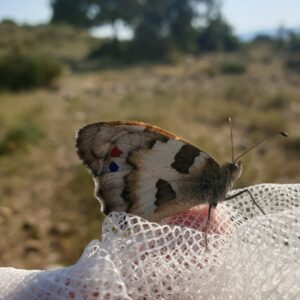The Hermit of Les Courmettes
One night in early June, a group of volunteers kitted out with head lamps were on their knees in a field at Les Courmettes, marvelling at the sight of a particular nocturnal caterpillar – that of a Hermit butterfly Chazara briseis.
In fact, two Hermit caterpillars were seen this season! While that may seem a low number, it is actually excellent news, as sightings are very rare. The Hermit is a species about which very little is known, and which is under threat both regionally and nationally in France. The Courmettes team launched a study protocol focusing on the Hermit species as part of France’s National Action Plan on butterflies.
 As adults emerged, from mid-July to mid-August, our attention turned to answering such questions as: how big is the population on site? What is the average lifespan of this butterfly? How far does it travel? How does it use the site? We did this through a technique called mark-recapture. The hope is eventually to compile our data with regional (and potentially interregional) data in a population genetics study, finances permitting.
As adults emerged, from mid-July to mid-August, our attention turned to answering such questions as: how big is the population on site? What is the average lifespan of this butterfly? How far does it travel? How does it use the site? We did this through a technique called mark-recapture. The hope is eventually to compile our data with regional (and potentially interregional) data in a population genetics study, finances permitting.
This year we marked 82 individuals – great news for the Hermit population of Courmettes! The next step is to analyse the data, but here are some first observations:
- Only males emerged in the first week of study; females emerged from the second week. After that, males and females emerged at the same rate.
- 41% of the individuals were recaptured at least once; some up to six times! Some individuals stayed in the same spot while others travelled further.
- Individuals captured at the end of the season travelled further than the early individuals.
We even witnessed individuals mating (bonus film here!) – evidence that the cycle of life continues. We still know very little about the host plants the Hermit prefers – come and join us in the 2023 season in our caterpillar hunt!
Photos: Hermit butterfly fieldwork in action – A Rocha France, Courmettes – 2022 July